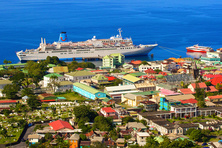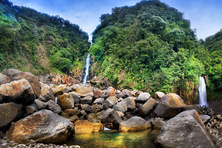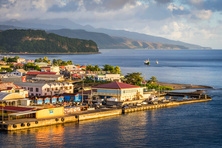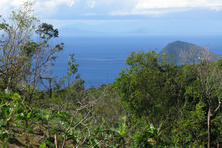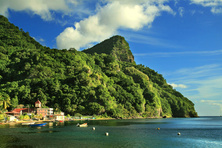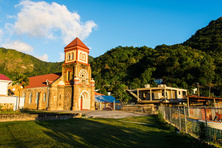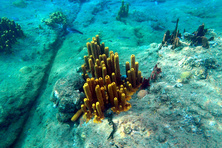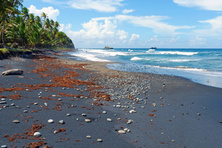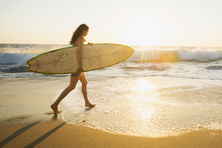Dominica
- Capital:Roseau
- Currency: East Caribbean dollar
- Time: UTC-4
- Languages: English
- Religions: Christianity (Catholicism, Seventh-day Adventists, Pentecostals, Baptists)
- Sections: Get in Visa Customs Cuisine Money Details of interest Popular resorts
Dominica or officially the Commonwealth of Dominica is a small island state in the Caribbean Sea. It does not have any land borders but its nearest neighboring countries are Guadeloupe and Martinique. The capital city is Roseau.
The climate in Dominica is tropical with trade winds. The temperature does not change much during the year. The dry season is spring and the wet season is summer and the beginning of autumn. The best time for holidays in Dominica is winter and spring.
The official language is English but the majority of the population speak French-based Creole dialect. Many of the locals are the Christians and half of them are the Protestants.
The tourists choose Dominica as a beach resort. The nature on the island is very beautiful. There are some interesting historical monuments and they will bring some diversity into your holidays.
You can relax virtually at any place on the coast but the most popular places among the tourists except the capital city are Berekua, Colihaut, Portsmouth, Point Michel, Rosalie, Saint Joseph and Wesley.
Dominica is one of the main destinations for divers. The choose the beaches near Soufriere and Champagne Beach. The surfers usually gather near Rosalie and on the east coast. The Layou River Gorge is a popular place for rafting. Within the island, the tourists can go hiking and horse riding.
Get in
By Plane
There are no direct flights between Dominica and Europe. The tourists can take transit flights with a stop in Antigua, Barbados, Guadeloupe, Martinique or Puerto Rico and then get to the Dominican airports Canefield and Melville Hall.
By Sea
Cruise ships sail across the Caribbean Sea all the year round and many of them arrive at the port in Dominica. One can get to the island only by a liner or a yacht which carries the tourists between the island states.
Visa
The tourists from EU and CIS countries can travel to Dominica visa-free. The tourists from European countries can stay in Dominica without a visa for six months and three months. The tourists from CIS countries can travel to Dominica without obtaining a visa for three weeks provided that they have a return ticket and do not add any security concerns.
The passengers of cruise ships also do not need a visa to stop in Dominica provided that they will leave the country on the same ship.
Customs
The tourists can import and export national and foreign currency in any amount but the money must be declared. The tourists can export only the amount of money they stated in the declaration. If the tourists export 2.500 XCD on the credit card account, they must confirm the origin of the money (the import declaration is usually enough).
The travelers can import in Dominica duty-free the following goods:
- a small amount of alcohol and tobacco;
- personal belongings and electronic devices in a reasonable amount.
It is strictly prohibited to import:
- offensive materials;
- some medications;
- knives and bladed weapons;
- plants and rare animals;
It is not allowed to export from Dominica:
- plants;
- rare animals.
Cuisine
The cuisine of Dominica as cuisines of many Caribbean countries was under a great influence of the Indians, Africans and Europeans (the French and the British). The staple foods are poultry, fruits, seafood and spices.
For a long time, it was a luxury to keep cattle on such a small island. That is why the Dominicans make traditional meat dishes with game or poultry and on big celebrations they cook goat. And only recently, the Dominicans began cooking expensive beef and pork.
The most exotic dishes you can try in Dominica are Manicou (smoked pork or smoked pigeon) and Agouti (fried or roast rat). The British sense of humor and French mastery in cooking were combined in a dish Mountain chicken. Do not be surprised when ordering this chicken, they will bring you the frogs' legs. In general, the local make usual European dishes only they add a lot of spices and sauces and use exotic fruits as a side dish.
Do not miss a chance to try local seafood dishes such as Tee-tee-ree (small fish cooked in a special way), Lambi (stewed clams) and Crabbacks (stuffed crabs).
The locals fry bananas, make soups and porridges from potatoes, yams, rice, annona, pea and maize. We recommend you trying these traditional dishes. They eat raw bananas, coconuts, paw paw, guava, pineapples and mango and cook them as well.
The most popular non-alcoholic drink is Sea Moss from seaweed. The locals also make drinks from plants in very unusual for the Europeans combinations.
The local alcoholic drinks are beer and rum which is not that good. But the Dominicans make very delicious cocktails with rum. Do not leave Dominica without trying a coconut cocktail with rum.
Money
The official currency is East Caribbean Dollar (XCD) which is equal to 100 cents. The bank notes from 50 to 100 dollars and the coins from 1 cent to 1 dollar are in circulation.
In Dominica, the tourists can exchange currency at banks and in exchange offices. The locals are willing to take US dollars but prefer not to accept payments in Euros and sterling pounds. However, it is more profitable for a tourist to pay with foreign currency than convert it into national currency.
The international credit cards are accepted in many hotels, stores and restaurants in the capital city and on the resorts. You can pay your booking almost in any hotel in Dominica. The Dominicans prefer the checks in US dollars.
Details of interest
Sightseeing in Dominica
In Dominica, there is one site inscribed in the UNESCO World Heritage List and the tourists can see it during their travel to this country. The site is the Morne Trois Pitons National Park. It contains a dense tropical forest and a picturesque landscape of a volcanic origin. The territory of the park is relatively small but you can see there high mountains, deep gorges, fumaroles, hot springs, freshwater lakes, dormant volcanoes and numerous waterfalls. In this park, there is the greatest biological diversity in the Lesser Antilles.
In Dominica, you will find places that are not under UNESCO protection, nonetheless they are also very interesting:
- Emerald Falls near Rosalie. This is a 12-meter waterfall right in the middle of a forest falling into the emerald lake. The Emerald Falls is the most picturesque place on the island.
- The Old Market Square in Roseau. This is a historical center of the city which preserved the colonial architecture.
- The village Bois Colette Estate which is one of the first European settlements. Here, you will see how the people lived on the island two centuries ago.
- Fort Shirley is where the British Army dislocated in the colonial period.
- The Indian village Carib Territory. Now this is an open air museum showing the everyday life of the natives before the Europeans came there.
Dominican Souvenirs
In Dominica, the tourists buy:
- crafts made of palm leaves;
- candles made of palm wax;
- traditional clothes and tablecloth with national patterns;
- necklaces, earrings and other things made of shells;
- amulets and masks;
- painted tableware and vases;
- jewelry.







